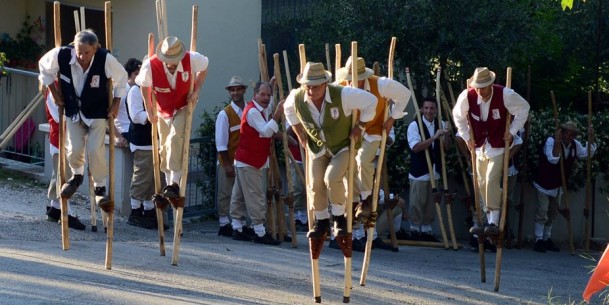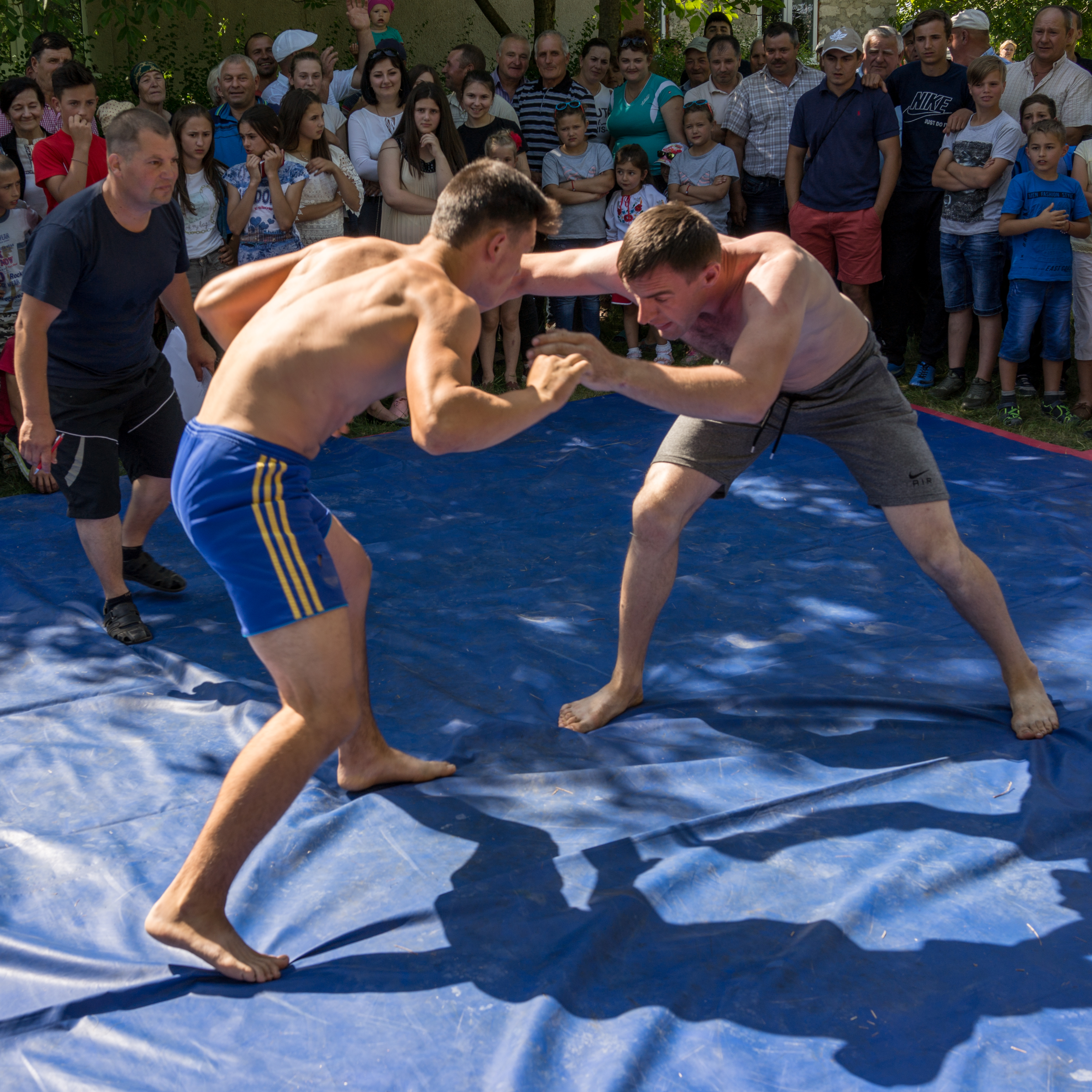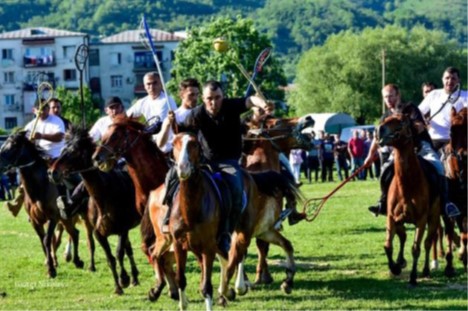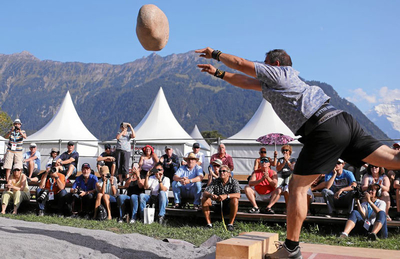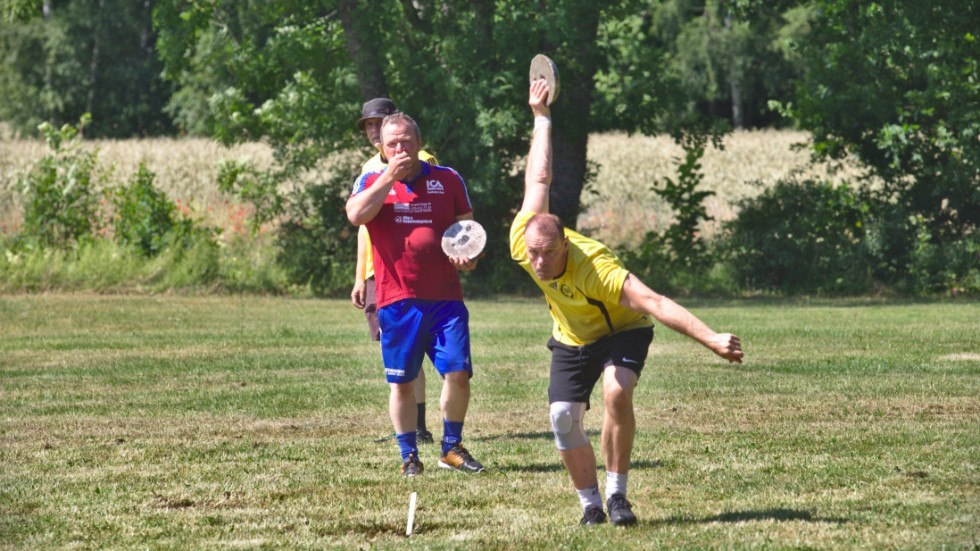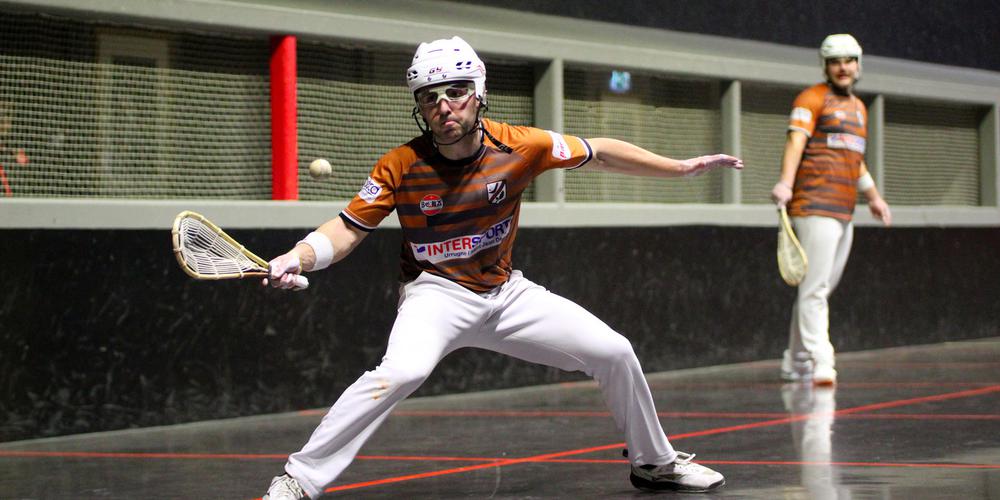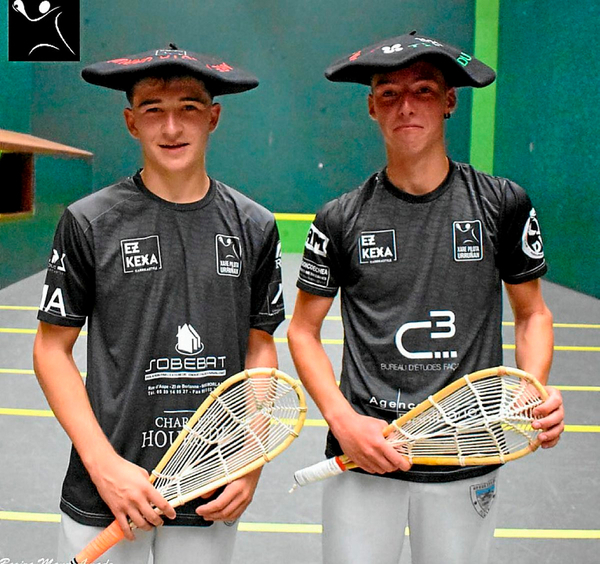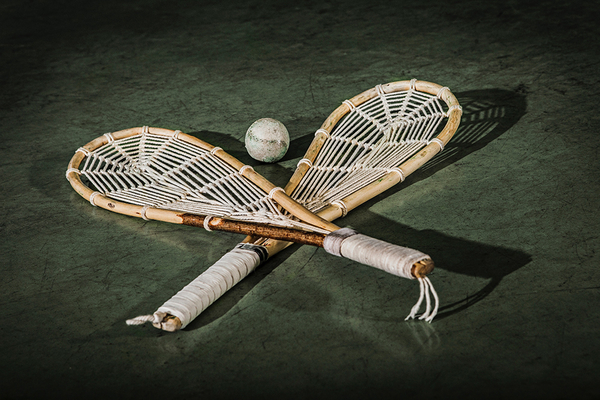- Name of sport (game): Trampoli
- Name in native language: Trampoli
- Place of practice (continent, state, nation):
Schieti, Italy
- History:
The art of stilt walking has long origins and is widespread in all continents; it comes from, among other things, the need to move around swampy areas, but with time it acquired ritual associations, it also became a spray competition.
Stilts have always been present in Schieti, the ancient castle at the crossroads between Pesaro, Urbino and Montefeltro, and a must-see for solfatari and charcoal smokers who made their way across the Foglia River on long wooden poles. - Current status:
Today, five city districts compete for the Palio dei Stiltoliers trophy from Schieti, competing on stilts all the way to the center of a medieval village.
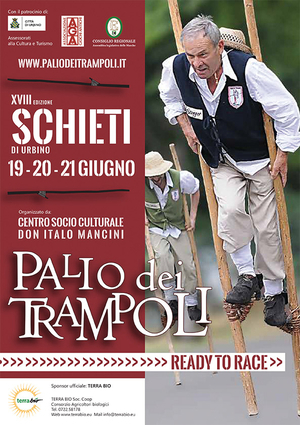
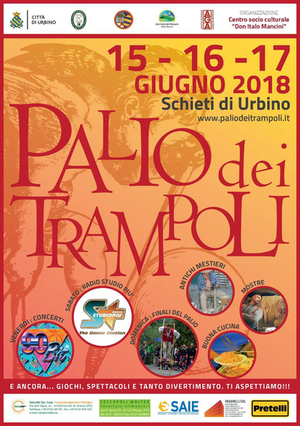
- Contacts:
Palio dei Trampoli
Centro Socio culturale “Don Italo Mancini”
Via del Castello, 6
61029 Schieti di Urbino (PU)
Tel. 340.7254596 – 320.0340126
www.paliodeitrampoli.it - Sources of information :
Video:
https://www.youtube.com/watch?v=kS2Egqvl6JI
https://www.youtube.com/watch?v=OMflEamy02g
https://www.youtube.com/watch?v=TlXSXXBUpA0
https://www.youtube.com/watch?v=a8huV32uQycSource of photos used in this article and gallery:
https://tenutasantigiacomoefilippo.it/en/the-palio-dei-trampoli-at-schieti-of-urbino/
https://www.paliodeitrampoli.it/
https://www.pinterest.it/pin/497507090081949173/
http://www.ilducato.it/2019/06/05/palio-dei-trampoli-a-schieti-dal-14-al-16-giugno-la-ventiduesima-edizione/
https://tocati.it/en/programma/trampoli-2/
http://www.provincia.pu.it/novita/visualizza/contenuto/palio-dei-trampoli-al-via-la-xx-edizione-a-schieti-di-urbino
https://www.donnaglamour.it/il-palio-dei-trampoli-di-schieti/guide-2/ - Gallery:
- Name of sport (game): Tranta, Trynta
- Name in native language: Trânta, Трынта
- Place of practice (continent, state, nation):
Moldova, Romania (Transylvania)
- History:
The historical and literary source denote the appearance of this fight "wrestle" at the end of the 14th - the beginning of the 15th centuries named squabble, being a means of physical training of the soldiers. The Moldavian fight was described for the first time in the ballads "Radu Calomfirescu" and "Mihu the Child" by the poet Vasile Alecsandri (1821-1890), while gathering folk creations of the 14-15 centuries. In the ballad "Radu Calomfirescu" it's visible that the squabble was also a heroic game, like those known under the French name "tournoi". In another ballad, distinctive elements of the fight between the Romanian Mihu and the Hungarian Ianus are described: a fight in all the chivalrous rules. First of all, both the fighters were sitting at the table, having some drink and then they began the fight, which did not start without audience. That is the fight, as the author said, took place on the ground, with application of different methods like twisting, hitting, throwing, casting to the ground. In Mihail Sadoveanu's novel "Nicoara Potcoava" the time of Stefan cel Mare is described, and the author reflects the traditions according to which the strongest heroes were chosen in the belligerent force and their fight was to decide the battle's result, for the whole army not to be exterminated. The fight victor was winning the war. In another novel by Mihal Sadoveanu " The brothers Jderi", one of the favorite proceeding of the national fight is shown. Thus, Ionel Par-Negru (black hair) defeated the Turk Uzun-Slondimb through shepherd's method: he went down on his back and threw the opponent over head, supporting him with a leg on his stomach, as out of a catapult. On holidays, the lads were assembling and beginning daring games. At the beginning of the fight they were grasping each other at waist in crossed motions applying various fight methods: lifting each other, dropping each other on the tendons, acting with legs, jumping. Bogdan Perticeicu Hasdeu in "Ion Voda cel Cumplit" wrote that the Moldavians liked target shooting and in this art only English archers were worth of them, but they preferred more the hand-to-hand fight. "The Ruler of Moldova has 30000 soldiers, 15000, the most brave among them possess the fight." The fighters were applying such methods as trips, jerking, shepherd's method (throwing over the head). The fight was taking place directly on the ground, in the presence of the audience, being escorted by a musical accompaniment; rude and harsh methods were not applied. The competitions were taking place with the occasion of popular and familiar holidays. They were beginning spontaneously as a wish to measure the strength and the skillfulness.
The Moldavian national fight appeared centuries ago in the nation labor activity process and was developed independently in various original forms, being both a means of the physical growth of the youth and of the training of the armed forces. The historical and literary archive informations helped at solving disputable problems as concerns the wrestle variants, certain technical proceedings, tactics, instruction methods, training for competitions, rules and conditions of the competition organization.
The analysis proves that two variants of the national fight existed at the Moldavians: with and without trips. The fight without trips was practiced in the north part of Moldova, but in the central and southern the trip was allowed as well as legs throwing over legs, over thigh. Although an organized instruction was in missing the fight rules and the skill were handed down from one generation to another in each village of Moldova.
In 1954 a group of young enthusiastic coaches set to themselves the goal to resurrect every sport. In the period of 1954 -1970 many skillful sportsmen appeared. All of them began their way in sport from the place when they were solving childish quarrels by means of wrestle. Among those are the ex-champions, multiple winners at different World competitions at sambo and judo - Valentin Gutu, Gheorghe Cotic, Constantin Bas; the country championship winners - the brothers Ion and Semion Curdov, Vasile Luca, Nicolae Goria; a whole pleiad of the Masters in Sport - the first Moldavian Champion at wrestle - Ghenadii Badanov, multiple victors and winners at Republican Championship, Ivan Dobrovolski, Dmitrii Tiron, Dmitrii Boieru, Nicolae Lutcanov, Petru Rusnac, as well as honored republican coaches at fights - Alexandru Hlistun, Petru Gherghi, Vasile Scurtul, Vasile Colta. In the last years, the national fight wrestle was a permanent element on every rural holiday, also at all the Spartakiadas of all the levels.
Source: https://ussrwrestling.narod.ru/mol_en.htm - Description:
Tranta is played on grass or mats, outdoor, during the summer local festivals.
Being a really national kind of sport, wrestle doesn't need special equipment and inventary and it can be practiced on any green field or even on a sand plot (of land). The Moldavian fight has many elements common both with wrestling and free fight, having, at the same time, its typical methods, which improved the arsenal of the sambo fight school.
· the fight takes place only in position, painful proceedings are prohibited;
· the fight's clothes consist of resistant trousers and a broad belt;
· footwear-soft, without heel;
· the grasp of hands, neck, body, girdle, clothes, leg and combined motions are allowed in the fight;
· the throwing are only through jerk, plunging, inclination over chest, shoulder, back, with legs, over legs and combined.
The fight begins with greetings and compulsory preliminary grasping of waist by both fighters concomitantly and in mid position. The goal of the fight is that to put touch the opponent and to hinder him in the position, or after throwing to press till he touches the carpet with shoulder blades. According to the rules elaborate in 1956, the duration of the competition is of 5 minutes for adults and 4 minutes for juniors. Unlike all the kinds of fight, excepting sambo and judo, in wrestle the turning over the shoulder blade is allowed at throwing over head. If that who throws over head is hindered by the opponent with sholder blades on the carpet hi is recognized defeated. In wrestle there are pure winnings and on the points. The sportsmen are divided into 9 weight categories. For the national a republican classification is created and unique category requirements and standards are established. - Current status:
Practiced
- Sources of information :
Books:
de П.К. Руснак, ТРЫНТА МОЛДАВСКАЯ НАЦИОНАЛЬНАЯ БОРЬБА, Картя молдовеняскэ / Cartea Moldoveneasca, RSSM / Republica Sovietica Socialista Moldoveneasca, 1987
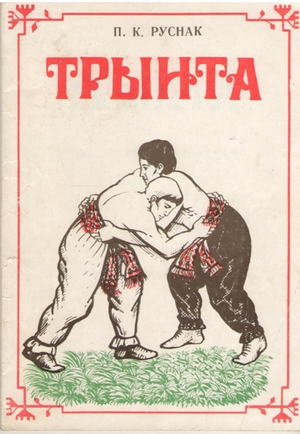
Articles:
https://ussrwrestling.narod.ru/mol_en.htm
https://ddn24.ru/activity/sport/trynta
https://judo.md/trintamd/41--trynta-nacionalnaja-moldavskaja-borba-.htmlVideo:
https://www.youtube.com/watch?v=T3LsQoIgMcM
https://www.youtube.com/watch?v=ut7TMX-T7usSource of photos used in this article and gallery:
https://topum.livejournal.com/392651.html
http://old.mts.gov.md/content/lupta-traditionala-tranta-parte-festivalului-artelor-nascute-din-traditii-ia-mania
https://ddn24.ru/activity/sport/trynta
https://novostipmr.com/ru/news/18-10-14/sportivnaya-stolica-ot-shashek-do-moldavskoy-borby-trynta
http://fotokto.ru/photo/view/7605531.html - Gallery:
- Name of sport (game): Trinta (Trinte) dreapta
- Place of practice (continent, state, nation):
Moldova
- Name of sport (game): tskhenburti
- Place of practice (continent, state, nation):
Georgia
- History:
The game of tskhenburti comes from ancient time in Georgia. This very interesting, national game was considered to be preferable entertainment of Georgian people. In that time, competitions with horses were the most beloved performance, where the horsemen had to demonstrate the art of riding horse and the mastery of using racket during playing ball.
- Description:
The game is held between two teams (6 participants in each) with wooden racket and rubber ball.
The players, divided into two teams, try to throw the ball in the rival’s maka, i.e. door. All players are permitted to move freely on the entire playground. Racket can be used to hit the ball on the ground as well as in the air, to catch the ball in the air, pass it, get back, transfer, etc. It is forbidden to hit the rider or horse with the racket. The door is protected by the defender. The game is held in two parts, each of them lasts for 10-15 minutes. The team, which throws more balls into the rival’s maka, will be considered the winner.
The game is held in two parts and lasts 30 minutes.
At referee’s sign (whistle) the teams, arranged in order, leaded by the team leader, trot to the playground and stand in the center facing each other. The team leaders greet each other. The circumference of the ball is 45 cm. The ball shall be painted in white. In old time, the ball used to be made of felt. It was to be wet and heavy.
Racket can be made of any material except iron. Often, the racket is made of walnut or other wood.
The part of the racket, intended for hitting, has oval shape, its length is 30 cm, and width (in the widest part) – 15 cm. The net of the racket can be made of rolled rope, leather or other material, but it shall not be made on iron in any case. - Current status:
Practiced
- Contacts:
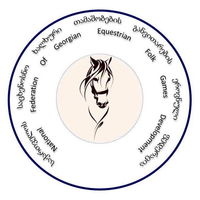
National Federation Of Georgian Equestrian Folk Games Development
David Tsirekidze, President
Address:
Georgia 0179, Tbilisi, Kipshidze str. 7g.
Telephone number: +995 595 989 292, +995 599 236 226,
E-mail:This email address is being protected from spambots. You need JavaScript enabled to view it. ,This email address is being protected from spambots. You need JavaScript enabled to view it.
Fb: https://www.facebook.com/National-Federation-Of-Georgian-Equestrian-Folk-Games-And-Equestrian-Sports-2136020253119407 - Sources of information :
The information contained in the article comes from the following sources:
Davit Tsirekidze, President of National Federation of Georgian Equestrian Folk Games DevelopmentSource of photos used in this article and gallery:
Davit Tsirekidze, President of National Federation of Georgian Equestrian Folk Games Development - Gallery:
- Name of sport (game): Tug of War
- Place of practice (continent, state, nation):
All the world
- Contacts:
Tug of War International Federation
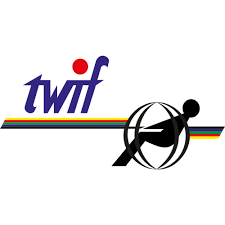
Mail address:
Lytse Dyk 2
9026 BD Jellum
The NetherlandsCourier address:
Lytse Dyk 2
9026 BD Jellum
The Netherlands
Telecom
Tel +31 6 23271158
EmailThis email address is being protected from spambots. You need JavaScript enabled to view it.
Web: http://tugofwar-twif.org/List of national federations of Tug of War and clubs around the world:
http://tugofwar-twif.org/member-associations/ - Sources of information :
https://www.nitowa.com/page-203-history-of-tug-of-war.html
http://www.tugofwar.co.uk/history-of-tug-of-warVideo:
https://www.youtube.com/watch?v=wMk_YxLQs_U
https://www.youtube.com/watch?v=olS8KC2T29o
https://www.youtube.com/watch?v=rBIRDoSnJC0 - Documents:
- Name of sport (game): Tzan
- Place of practice (continent, state, nation):
Valle d'Aosta, Italy
- Sources of information :
- Name of sport (game): Unspunnen
- Place of practice (continent, state, nation):
Switzerland
- Description:
Unspunnen is one of the traditional Swiss sports, which involves throwing a stone weighing 83.5 kilograms.
The original stone was stolen in 1984 by the Belier group, which fought to disconnect the entire Canton of Jura from Bern. However, this did not discourage fans of this unusual sport and they found a new stone.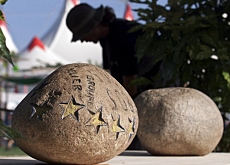
In 2004 Markus Maire from Plaffeien (FR) meters set an “all-time record”, he pushed the stone 4.11 meters away. - Gallery:
- Name of sport (game): Vallay
- Name in native language: ВӘЛЛӘЙ
- Place of practice (continent, state, nation):
Russia
- Description:
The novice player lays a “balichuk” peg on the bricks, pushing the “anayagach” stick from below, lifting it, sharply hits the balichuk. The second team immediately runs in the direction of the flying peg in order to catch it in a skullcap or hat. And if they catch the balichuk, then the second team starts playing the game. And if they do not catch the balichuk, then the player continues the game from the place where the balichuk fell. Again they put two bricks, put a balichuk on it and again hit it with a yagach. When hitting a brick, the other team continues the game, then, throwing up a balichuk three times, hits it, and if at this moment the second team still catches the balichuk, then the first team is considered the loser.
- Sources of information :
- Name of sport (game): Varpa (kast varpe)
- Place of practice (continent, state, nation):
Sweden, Scandinavia
- Sources of information :
Articles:
http://www.guteinfo.com/?id=3794
https://www.varpakungen.com/om-oss/Video:
https://www.youtube.com/watch?v=m1nUDx80vcg&t=1sSource of photos used in this article and gallery:
https://www.guteinfo.com/index.asp?id=1202
https://sverigesradio.se/artikel/klintehamn-tar-over-installda-sm-tavlingar
https://helagotland.se/bli-prenumerant/artikel/r271d57j/gt-2m2kr_s_22
https://www.kappelshamnsik.se/2014/07/kenneth-och-sune-tog-var-sitt-varpaguld-igen/ - Gallery:
- Name of sport (game): Viopaîni
- Place of practice (continent, state, nation):
Finland
- Name of sport (game): Xare (share)
- Name in native language: xare
- Place of practice (continent, state, nation):
Basque Country, South America
- History:
It is an ancient sport and perhaps the least practiced than the rest of the racket games.
However, it has great cultural value and that has kept it rooted not only in Europe, but also in some Latin American and Caribbean countries.
The Xare or Share is a ball sport born in the Basque country, located in the territory between Spain and France.
It is a name given to a modality that has the same characteristics as Basque pelota, that is, speed and precision. In this way, players will be able to reach their goal during the match.
Share means network. It is even the same term to refer to the rackets with which it is played.
The Share is related to a variety of ball games that were played between the 12th and 14th centuries, one of them being the Jeu de Paume or palm game.
The truth is that this sport originated in the Basque country, where there is evidence of Basque religious groups, Jesuits and Capuchins, who were the first to give it meaning until they turned it into a hobby. Consequently, it is popularized in Spain, where society still values it for being a sport inherited from its historical past.
However, other theories record its origin in the Betharram Valley in the Atlantic Pyrenees, France.
The Share also spread to other countries. In fact, this specialty of Basque pelota reached Argentina at the end of the 19th century and at the beginning of the following it began to have a greater participation. In this South American country, they gave it the name "Raqueta Argentina". In addition, the share was taken into account for the Basque Pelota World Cups that were held for the first time in 1952. - Description:
Xare is one of the disciplines of the sport Basque pelota. It is played with a racket and a ball in a court called a trinquete. Xare is very popular in South America and is played by both men and women of all ages.
Like other Basque pelota sports, share is played in pairs and is only allowed for men or individually.
The game takes place in the ratchet, which is a space surrounded by four walls, each one with its respective name, the most prominent being the "frontis" or front that serves as a receiver of the ball.
To achieve this goal, players use the share or racket to lightly retain the ball without hitting it.
In this way, they manage to return it with force and make it bounce against the wall using a series of techniques, that is, with movements of the hand and wrist.
The strategic play consists of defending the ball thrown by the rival team until obtaining the majority of points. A match is played between two two-player teams. The rules are similar to other wall-based sports, where the ball has to be returned back to the front wall with at most one bounce on the ground. The ball is allowed to bounce any number of times or even roll on the roof of the facade. Teams score points if the opponents are unable to return the ball back onto the wall. Matches are played in points and sets format.
In general, each game lasts approximately 20 minutes, however, the time may change.
On the court, the pelotaris can move backwards, forwards and to the sides, but the changes of position that they most often make are the frontal and rear ones, where the opponent executes offensive plays.
In the share, 40 points are played or through two sets of 15 points each.
The share is played on a rectangular court called a ratchet. In itself, it is a closed space that has a length between 28.5 and 30 meters, 8 meters high and wide.
It also consists of four walls: One Frontal, rebound, one right and one left.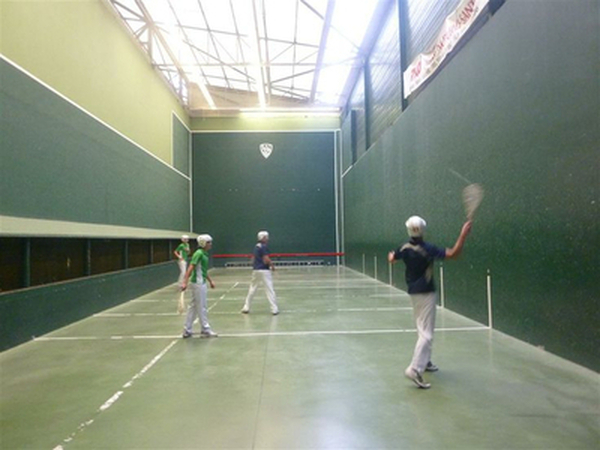
https://pl.pinterest.com/pin/385550418071082743/The court used for playing xare consist of walls on all four sides. The left wall features a facade, about 2ft wide with a slanting roof, that projects onto the court. Unlike racquets used for other sports where the strings are tight, the strings in xare racquets resemble a woven mesh. Rather than striking the ball, the action resembles more like a catch and throw using the racquet. Besides the racquet and a ball, a bicycle helmet is the only other equipment used. In this sport it is essential that players wear a helmet as a protection measure. It is a fundamental rule, due to the speed that the ball reaches during the match. Consequently, an impact to the head can cause serious injuries. It does not require demanding clothing. Pelotaris wear pants and a short-sleeved shirt.
The materials that characterize this game are the ball and the share itself. Well, in this sport, the players use a racket made of wicker and cotton rope that is intertwined, slightly taut and fastened on the inside. The combination of all these materials will allow you to retain the ball for moments and send it back against the wall.
The rackets are 58 centimeters long and 18 centimeters wide approximately.
The balls are covered with leather and have a hard consistency. In general, they are 55 millimeters in diameter, and their weight is 83 grams. - Current status:
Practiced

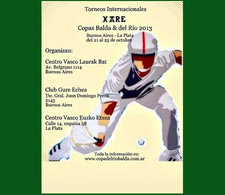
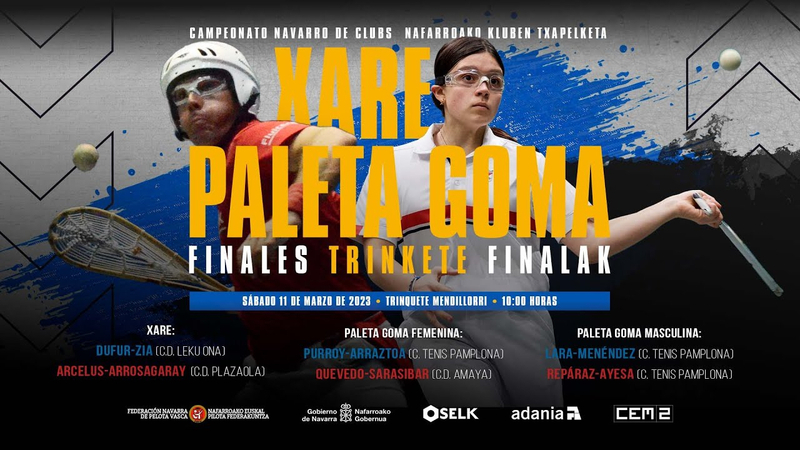
- Contacts:
Federación Internacional de Pelota Vasca
Pabellón ARENA – Casa del deporte
Plaza Aizagerria, 1
31006 – Pamplona (ESPAÑA)
Web: http://www.fipv.net
E-mail:This email address is being protected from spambots. You need JavaScript enabled to view it.
Tel.: +34 948 164080
Fb: https://www.facebook.com/pelotavascafipv/
Instagram: https://www.instagram.com/fipvoficial/
Twitter: https://twitter.com/FFIPVOficial
YouTube: https://www.youtube.com/channel/UC2WtobEr8XIZNnudXbUlUnQ
Flickr: https://www.flickr.com/photos/48286071@N06/albums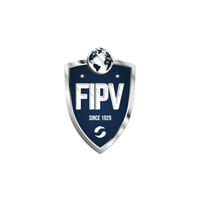
- Sources of information :
Books:
Pablo Ubierna, El Xare , La raqueta argentina, Una historia de la Pelota Vasca en el Rio de la Plata, Edicione Zubia, 2015Articles:
https://www.iris-france.org/157700-diaspora-and-sport-pelota-and-identity-in-different-communities/Video:
https://www.facebook.com/watch/?v=816027772131679
https://www.youtube.com/watch?v=jEedhJGg5Tw
https://www.youtube.com/watch?v=_YFKKP57wKc
https://www.youtube.com/watch?v=4wDLZ6usbx4
https://www.youtube.com/watch?v=EsUI7zTYYjo
https://www.rtve.es/play/videos/aqui-la-tierra/aqui-tierra-share-deporte-peligro-extincion/4320399/
https://www.youtube.com/watch?v=WdCvCZ207PIThe information contained in the article comes from the following sources:
https://www.topendsports.com/sport/list/xare.htm
https://fipv.net/en/xare/
https://raquetados.com/deportes/xare-o-share/Source of photos used in this article and gallery:
https://www.sudouest.fr/sport/pelote-basque/mondiaux-de-pelote-basque-le-xare-fait-son-grand-retour-12694178.php
https://raquetados.com/deportes/xare-o-share/
https://www.mediabask.eus/es/info_mbsk/20210910/arrizabalaga-et-castera-s-adjugent-le-tournoi-de-xare
https://manista.blogs.com/amateur/2009/10/espa%C3%B1a-pierde-ante-argentina-la-final-de-paleta-goma-femenina-en-el-mundial-sub-22-de-trinquete.html
https://www.mediabask.eus/es/info_mbsk/20220818/seize-jeunes-preparent-les-mondiaux
https://www.diariovasco.com/deportes/pelota/joxi-lopetegi-medalla-plata-mundial-xare-20221028143540-nt.html
https://fipv.net/author/joseangel/page/47/
https://pl.pinterest.com/pin/385550418071082743/
https://www.mediabask.eus/es/info_mbsk/20221222/noizbait-a-nouveau-reine-du-xare
https://www.diariovasco.com/tolosa-goierri/partidos-xare-pelota-20200117004556-ntvo.html - Gallery:
- Documents:
 Lourdes_Labaca_Zabala_El_Xare_modalidad_de_pelota_vasca_como_patrimonio_cultural_inmaterial.pdf
Lourdes_Labaca_Zabala_El_Xare_modalidad_de_pelota_vasca_como_patrimonio_cultural_inmaterial.pdf

